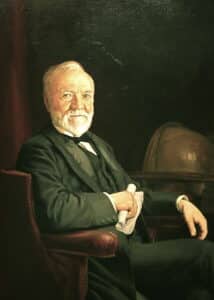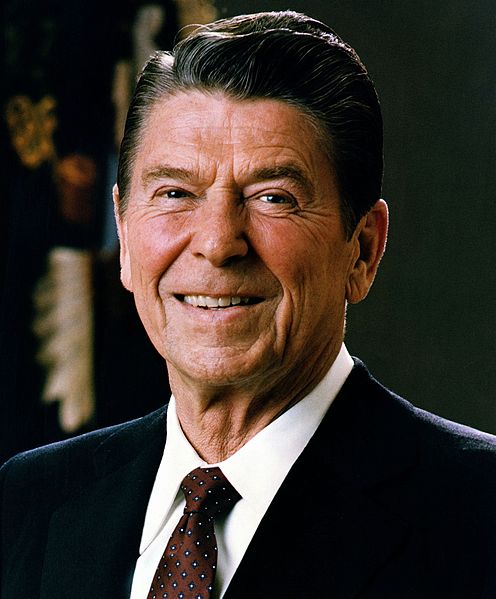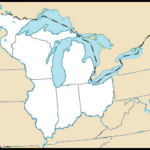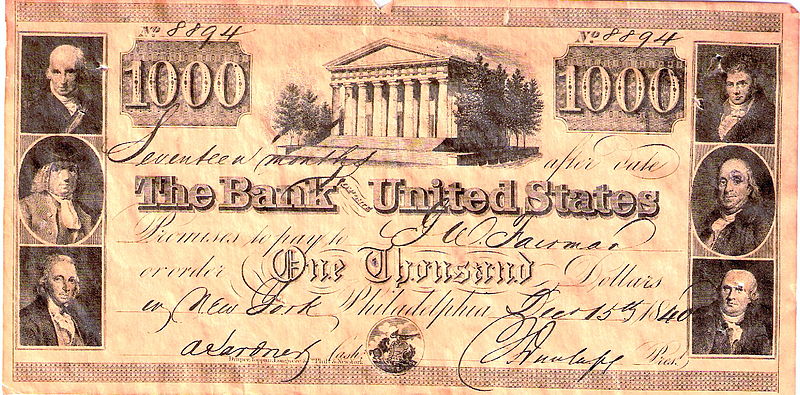The Gospel of Wealth sounds like a concept anyone can get behind, right? I mean, there’s wealth right there in the title! But what is it really? Keep reading for Gospel of Wealth APUSH topics.
What is the Gospel of Wealth?
If you’ve ever been to a Christian church service, you may have heard the term “gospel” before. The word doesn’t necessarily have to be connected with religion, though.
Gospel come from two words in Old English: gød, which means good, and spel, which means story or news. So, gospel means “good news”. It can also refer to a set of principles or beliefs an individual may have.
Both definitions apply in this case.
The Gospel of Wealth was an idea made popular by industrialist Andrew Carnegie in 1889. In an article he wrote titled “Wealth”, Carnegie described his belief that it was the moral responsibility of the rich (especially the self-made rich) to tackle wealth inequality by giving their surplus wealth to those who were less fortunate. Carnegie argued that the rich should give to any number of public institutions, including libraries, museums, and concert halls.

Andrew Carnegie, c. 1905 (Source)
As he wrote in his article, Carnegie’s purpose in spreading the Gospel of Wealth was
-
“…to present some of the best methods of performing this duty of administering surplus wealth for the good of the people. The first requisite for a really good use of wealth by the millionaire who has accepted the gospel which proclaims him only a trustee of the surplus that comes to him, is to take care that the purposes for which he spends it shall not have a degrading pauperizing tendency upon its recipients, but that his trust shall be so administered as to stimulate the best and most aspiring poor of the community to further efforts for their own improvement….It is ever to be remembered that one of the chief obstacles which the philanthropist meets in his efforts to do real and permanent good in this world, is the practice of indiscriminate giving and the duty of the millionaire is to resolve to cease giving to objects that are not clearly proved to his satisfaction to be deserving….Greater good for the race is to be achieved by inducing them to cease impulsive and injurious giving.”
Source: University of Virginia
There’s a lot of words in there, but what it means, in more plain language, is that rich people shouldn’t just give their money to the poor all willy-nilly. Instead, the rich should give their money to institutions or ideas that promote the poor to cultivate “better” habits. The rich should not give money that has a “pauperizing tendency upon its recipients” – meaning that the rich shouldn’t just give the poor money that the poor don’t have to work for.
Carnegie believed that his wealth was given to him by divine intervention, and that it was the responsibility of rich people to use their money to encourage good habits among the poor. Furthermore, Carnegie is asking something huge here: He’s trying to convince a bunch of rich dudes to give MOST of their money to charity, rather than giving their families receive an enormous inheritance (although the inheritance would likely still be huge).
Interestingly enough, there is a modern version of this Gospel of Wealth in the form of Bill and Melinda Gates and Warren Buffet’s Giving Pledge. It’s not exactly the same, but there are some interesting parallels that you might want to look into.
Cool idea. But why does the Gospel of Wealth matter?
Carnegie is an interesting figure who provides a nice link between the Gilded Age and the Progressive Era. He came to America as an immigrant from Scotland. He made his money in the steel industry and became a tycoon of industry. This is a standard Gilded Age narrative. But Carnegie also was a progressive in that he believed the wealth inequality was a problem that he, as a rich man, had a duty to try and solve (likely because he grew up poor). However, like many other Progressive Era reforms, there was a note of condescension in his philanthropy.
Carnegie believed he knew what poor people needed. Instead of paying employees a living wage, why not build libraries? To be fair, that line of questioning is a much more radical critique of Carnegie than was popular at that time. Even the famous photographer of the urban poor, Jacob Riis, would work with industrialists to get money. However, it is important to understand how Carnegie’s Gospel of Wealth reinforced, instead of dramatically transformed, the wealth inequality he was seeking to ameliorate.
What are some example Gospel of Wealth APUSH questions?
While you may not be asked explicitly about the Gospel of Wealth on its own, you are likely to be asked about Progressive Era policies. You can use the Gospel of Wealth as an example of a line of thinking that was a complex, messy example of the benefits and constraints of progressivism.
The following Gospel of Wealth APUSH questions come from the 2017 APUSH practice exam. The photo has been changed to ensure that all images posted on this website are in the public domain.
The questions below refer to the following photograph taken by Jacob Riis in 1890.

(Source)
1. Conditions like those shown in the image contributed most directly to which of the following?
A. The passage of laws restricting immigration to the United States
B. An increase in Progressive reform activity
C. A decline in efforts to Americanize immigrants
D. The weakening of labor unions such as the American Federation of Labor
2. The conditions shown in the image depict which of the following trends in the late nineteenth century?
A. The growing gap between wealthy people and people living in poverty
B. The rise of the settlement house and Populist movements
C. The increased corruption in urban politics
D. The migration of African Americans to the North
3. Advocates for individuals such as those shown in the image would have most likely agreed with which of the following perspectives?
A. The Supreme Court’s decision in Plessy v. Ferguson was justified.
B. Capitalism, free of government regulation, would improve social conditions.
C. Both wealth and poverty are the products of natural selection.
D. Government should act to eliminate the worst abuses of industrial society.
Bonus Gospel of Wealth APUSH question (not from the APUSH Practice Exam):
4. How would an individual who subscribed to the beliefs of the Gospel of Wealth interpret the following photograph?
A. The government should get involved to provide more homes for homeless children.
B. The rich should provide funds to institutions that help homeless children.
C. Industrialists should pay individuals more so that they can afford to live in decent homes.
D. The nature of capitalism makes it so that there will be poor people, and there is nothing to be done about it.
Answers
The correct answers to these example Gospel of Wealth APUSH questions are:
- B
- A
- D; if you got tripped up on this one, notice that the question does not ask how Carnegie would respond to this picture. Instead, it asks how anyone who advocates for the individuals in that photograph (think Jane Addams) would respond. As always, multiple choice questions require you to choose the one best answer out of the answer choices given.
- Bonus question: B





Leave a Reply